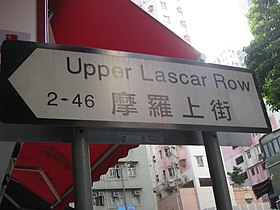Upper Lascar Row
| 摩羅街 | |||||||||||||||||||||

Street sign in Sheung Wan
|
|||||||||||||||||||||
| Maintained by | Highways Department | ||||||||||||||||||||
|---|---|---|---|---|---|---|---|---|---|---|---|---|---|---|---|---|---|---|---|---|---|
| Length | 225 m (738 ft) Upper Lascar Row: 168 metres (551 ft) Lower Lascar Row: 57 metres (187 ft) |
||||||||||||||||||||
| Other | |||||||||||||||||||||
| Status | Pedestrianized | ||||||||||||||||||||
|
|||||||||||||||||||||
| Lascar Row | |||||||||||
| Traditional Chinese | 摩羅街 | ||||||||||
|---|---|---|---|---|---|---|---|---|---|---|---|
| Simplified Chinese | 摩罗街 | ||||||||||
|
|||||||||||
| Transcriptions | |
|---|---|
| Standard Mandarin | |
| Hanyu Pinyin | Mōluó Jiē |
| Yue: Cantonese | |
| Yale Romanization | Mo1 lo4 gaai1 |
Lascar Row is the combined name of two streets between Hollywood Road and Queen's Road Central in Sheung Wan, Hong Kong. The streets are Upper Lascar Row (摩羅上街) and Lower Lascar Row. "Lascar Row" usually refers to the former, since most of Lower Lascar Row was redesigned for vehicular traffic and renamed Lok Ku Road. With many antique shops, Lascar Row is a popular tourist destination.
Although 摩囉 is not in the Chinese dictionary, its meaning stems from the English word lascar. Derived from the Arab-Persian lashkar (military camp), it was used by the British to refer to South Asian seamen. The word 摩囉 comes from "Musselmen", Muslims from the Middle East who traded in China. Early Europeans in Southeast Asia used mouro in Portuguese or morro in Spanish, and Musselmen gradually became "Morra". "Row" derives from the row of houses which accommodated South Asian seamen.
The South Asian community had a small market. Since the 1920s it gradually developed as a market for a wide range of antiques, including obsolete electrical appliances. It and the neighbouring Hollywood Road became known as Antiques Street.
Cat Street (貓街) derives from the sale by some shops of stolen goods, known as "mouse goods" (老鼠貨) in Chinese. With its lower prices, many were attracted to shop in the area. Shoppers who walked cautiously down the street while selecting their goods were likened to cats trying to catch a mouse. Foreigners, particularly, came to refer to Lascar Row as Cat Street.
Upper Lascar Row is a narrow alley in Mid-Levels which runs parallel to Hollywood Road on the north side. The straight alley measures over 500 feet (150 m), and there was an Indian police dormitory in the street. On 11 February 1911 a fire broke out on Upper and Lower Lascar Row, destroying 16 houses and damaging another 24.
In Chinese, it is common to use 摩囉 ("Moors") to refer to South Asians from India, Pakistan, Bangladesh and Sri Lanka. This reflects the pre-European colonial role of Muslim South Asian trading connections with southern China. The S61 and S62 historic blocks of the former Whitfield Barracks at Kowloon Park in Tsim Sha Tsui are known as the Moors Soldiers Barracks (摩囉兵營).
...
Wikipedia
